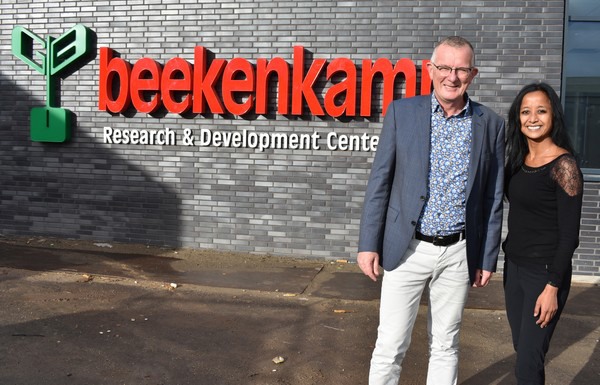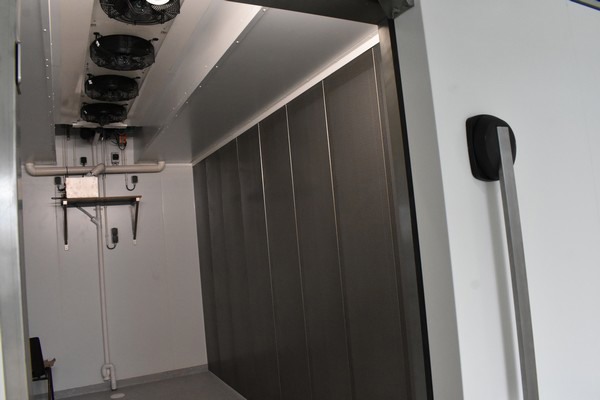Last week, in the Netherlands, Beekenkamp Plants Ornamentals' breeding greenhouse relocated from the Deliflor site in Maasdijk. It is now housed in the Beekenkamp Group's brand new Research and Development Center a short distance away. The Beekenkamp Plants Ornamentals breeding activities have merged with the group's elite departments and its research and tissue culture lab. Its new headquarters are also located in the Research and Development Center, which is state-of-the-art in terms of technology and hygiene.

Marc Driessen and Sirekit Mol, Marketing Manager & Global Head of Product Trade.
“I'm a bit of a dreamer," says Marc Driessen, Beekenkamp Plants Ornamentals Director. "I've had this dream for years, and finally, the company decided to bring it to life. I'd envisioned this exact Research & Development Center for the entire Beekenkamp Group. The neighbors from across the street indicated they wanted to stop farming at this location, and we were ecstatic. This was a once-in-a-lifetime opportunity, which we took. A place within walking distance of many of the group's current locations was truly a gift. I'm delighted and very excited now that it's here."
 The breeding division's fixed breeding tables.
The breeding division's fixed breeding tables.
Clean, cleaner, cleanest
Building began on February 4, this year. "We've had the wind at our back, and we're now starting to put in the first plants as scheduled," says Marc. Starting fresh, as they are doing now, is nothing new for the group. "Our elite departments can now begin with entirely new plants. Most of these come from tissue culture, so diseases or pests aren't brought in."
 The Moleaer nanobubble systems
The Moleaer nanobubble systems
The new premises spans 2.2 hectares. It has 28 greenhouse divisions, a processing area, a canteen, laboratories, and meeting rooms. The water technology area "is extensive and very diverse," says installer Royal Brinkman, "thanks to the wide variety of cultivation systems. There is drip irrigation on cultivation tables and an overhead sprinkler system. Then there's a high-pressure misting system, and there are ebb and flow systems on concrete floors and cultivation tables. We've installed a double water system and drainage system. There also are two Moleaer nanobubble plants, which use UV to disinfect the water and enrich it with oxygen," explains the installer. There is no boiler: the heating is connected to Deliflor's existing heating system.
 The air treatment technical area.
The air treatment technical area.
The greenhouse power is connected to the Beekenkamp network. Hopefully, this can soon be connected to the local geothermal heat network. There is also a plan to invest in solar panels, which should provide enough electricity for the cooling cells.
 Breeding cells in the lab.
Breeding cells in the lab.
 The inside of a breeding cell.
The inside of a breeding cell.
Separating that which can be separated
It is 'vitally important' that all the plant material is 100% clean and disease-free. The company has, thus, tried to keep the breeding as separate from all other possible activities as it can. For example, practically all the equipment needed to run the phytotrons and cooling rooms are located outside the rooms themselves. If anything breaks down, maintenance engineers will then hardly ever have to work in a cell or refrigeration unit itself.
The 'clean' lab and elite departments are divided into eight and there are very strict clothing protocols. No one enters who has no business being there, and employees have to change their clothes not once but twice - once when entering the greenhouse, and again when entering a department. A double hygiene lock, in other words.
All the tables are also deliberately fixed to the ground, meaning the plants cannot touch each other, not even accidentally. "It's an expensive way of working," Marc admits. "There will be relatively few plant rotations and a lot of manual labor, but clean starting material is so important. Thus, we wanted to do everything in our power to guarantee that at all times."
Then there is a 20-division 'dirting' breeding department. Again, there is no messing about here. Experiments created in the lab, as it were, are tested in practice here. Like the elite department, it is fully equipped with a concrete floor, but there is no LED (but HPS, 1000W). Vertical fans ensure a homogeneous climate, and the entire facility has three screens. Plants are propagated on both ebb and flow tables and floors.
All initial breeding is done at this location. If larger quantities are required, Beekenkamp will outsource this. The company has access to elite departments at other production sites too. These are in Ethiopia, Uganda, and Mexico, where the company does its own propagation.
 The new canteen.
The new canteen.
Ready
Lastly, the lab focuses primarily on variety conservation for Ornamentals and Deliflor's Chrysanthemums, but it is also available to the entire Beekenkamp Group, including Beekenkamp Vegetables. Potatoes will be bred here for them. "Thanks to our new R&D Center, we have gained 250 m2 of lab space. That means we've doubled our research facilities. We have much more space for research, and some room has been freed up at Deliflor, where we now have more space for things like marker research, and a separate lab for phytosanitary research. In short, we hope to be able to move forward for a while," Marc concludes.

The various departments each have separate offices.
For more information: Beekenkamp Plants
Beekenkamp Plants
Email: [email protected]
Website: www.beekenkamp.nl










